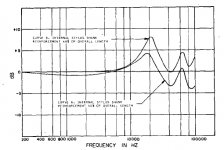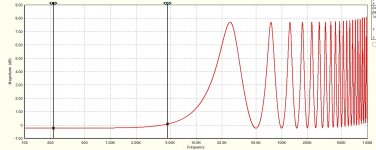No, to make it conform to the RIAA, you must let the mechanical resonance fill in for the roll-off caused by the electrical resonance. The right combination makes for a flat response.
Here's a couple of illustrations of just the mechanical response. First is from a Happ/Shibata (IIRC) paper, second is my own simulation which shows a full series of Eigen resonant peak/troughs. The Happ/Shibata image just shows the first two. Only the first one typically affects the audioband, though the 2nd could be a nuisance for quad carriers.But I have no idea what the mechanical resonance does to the response and if that is significant enough to be of concern. Does anyone bother with a parametric to deal with this?
Common wisdom and lore has it that the resonant system comprises vinyl spring/tip effective mass. However, that is contradicted by the presence of a series Eigen resonant peaks. Whereas self-resonance of the cantilever by way of flex has the correct form and simulations fit - this is far more likely in my view.
Yes, the 1st peak of the system is generally arranged to augment the natural post resonance roll-off from the LCR so as to extend hf response for MMs. In MCs the resonance is arranged to be damped, but often shows up as a peak in the upper hf part of the audioband, and a second peak in the ultrasonic range.
Attachments
Has there really ever been a topology that intentionally passes dc current in the cartridge coil ?
Yes, the M1, as shown in the schematic.
I see the source of confusion - that schematic has an input cap added that doesn't belong.
Last edited:
It's a cultural / ritual / ownership thing. Like vintage cars. 🙂
Jan
But a lot cheaper than vintage cars!
Why waste time on any of this? Meridian has reinvented the whole audio chain with MQA. It makes things sound better than the original. . .
Cool right... as Jimi said blah blah woof woof.
Here's a couple of illustrations of just the mechanical response.
Lucky I never asked, what brought you to this state of phonophilia? Much respect BTW to your inputs.
Wading through Laloum's pages the first thing that strikes me is there is a lot of variance in all the published frequency response measurements so bag of salt at the ready but his do seem the most credible. Two things jump out as interesting
https://sites.google.com/site/zevaudio/turt/cartridge-comparison-list/audio-technica-at440mla
The AT needs pathologically low C as SY has written about, but with that and a reduced resistance is +/-1.5dB across the band. But with a std phono stage and setup you are nearly 3dB up at 10KHz. But is that the stylus resonance that appears around 15KHz?
https://sites.google.com/site/zevaudio/turt/cartridge-comparison-list/shure-v15v
Is even more interesting to me as it's a stylus I was thinking of trying (Jico SAS) in a shure V15 body. The SAS has a very distinct mechanical resonance that needs huge C to tame. And am I right in assuming that is what Brad was talking about when warning against assuming a damped RIAA would give a flat response?
Sadly no measurements of the AT150MLx which seems the cream of the current MM crop if you can load it right, but I can see why the old guard back in the late 70s recommended the VST series.
https://sites.google.com/site/zevaudio/turt/cartridge-comparison-list/audio-technica-at440mla
The AT needs pathologically low C as SY has written about, but with that and a reduced resistance is +/-1.5dB across the band. But with a std phono stage and setup you are nearly 3dB up at 10KHz. But is that the stylus resonance that appears around 15KHz?
https://sites.google.com/site/zevaudio/turt/cartridge-comparison-list/shure-v15v
Is even more interesting to me as it's a stylus I was thinking of trying (Jico SAS) in a shure V15 body. The SAS has a very distinct mechanical resonance that needs huge C to tame. And am I right in assuming that is what Brad was talking about when warning against assuming a damped RIAA would give a flat response?
Sadly no measurements of the AT150MLx which seems the cream of the current MM crop if you can load it right, but I can see why the old guard back in the late 70s recommended the VST series.
I fear vinyls will never be any more.Everything old is new again. 😉
A brand new class of super audiophiles emerges?
Those who kept their quality vinyl playback gear?
Those who kept their quality vinyl playback gear?
Thank you. Wow. That is somehow very humbling to know.Yes, the M1, as shown in the schematic.
I see the source of confusion - that schematic has an input cap added that doesn't belong.
But a lot cheaper than vintage cars!
Really? I was just oogling a $120k turntable the other day .... 😉
Without cartridge of course.
Jan
Ahah...... to make sense of any thd spot frequency test result it's necessary to know the level and frequency of the test tone, where it is on the record, and the speed of the disc (33/45 rpm). I can't see from the documentation of Adjust+ what level the test tone is ? This matters if one is ever to use the result as a figure of merit, or compare with another result from another measurement system.
Of course. It's a 1kHz tone at 33.33 RPM at 0dB - which I guess is 5cm/s modulation.
But I'll ask Dr. Feickert.
Jan
Thanks, Scott.Lucky I never asked, what brought you to this state of phonophilia? Much respect BTW to your inputs.
Cripes, I hate to think what led to this. I have time to indulge what I enjoy, and, being an electronics designer with a classical physics education I seem to have something left in the tank for it. I love sound. Having also been an audio studio engineer, I'm passionate about bona fide authentic mastered sound that is locked in to what is only in those original grooves. That provides opportunity and motive I suppose.
I hate loose ends in technical understanding, and just feel compelled to pull on them. IME if one does that for much/most current conventional wisdom in vinyl playback, explanations typically unravel and fail scrutiny at any satisfying level. Then it's just rude not to give mindshare to the physics of vinyl playback in the broadest sense with a view to understanding without loose ends, and with satisfying self-consistent explanations, without contradictions. The upside is in making better decisions about setup and configuration, leading to playback performance beyond what might be currently considered optimal. Where that requires mechanical or electronic design, as it often does, I'm in a position to provide it.
Lost in myths and whispers over the years perhaps, but much conventional wisdom that survives sure is sub-optimal IME.
Thanks for asking, Scott.
A brand new class of super audiophiles emerges?
Those who kept their quality vinyl playback gear?
Most music lovers kept their vinyl.
Optical Phono Cartridge
Don't know how they work.
Another example.
Beatles song sounds clean at 2:20.
Active Headshell
Is the shielding from interference only advantage ? Why would it affect only low level signal and not preamplified signal ? Such a small preamp must be digital.
Regards.
Don't know how they work.
Another example.
Beatles song sounds clean at 2:20.
Active Headshell
Is the shielding from interference only advantage ? Why would it affect only low level signal and not preamplified signal ? Such a small preamp must be digital.
Regards.
Most music lovers kept their vinyl.
Perhaps where you live that is so, Bill. Where I live, most people have gotten rid of their turnatbles and LPs and have gone over to the CD camp. A very convincing majority, but of course, some of us keep both. Of the CD only camp, it is dominated by younger people with less years under their belts than the CD format. To be expected, I suppose, they never had the opportunity to collect many LPs.
And the rapid deterioration of the local standard of living didn't help much, it all but coerced people to go for Bulgarian and Chinese pirated CDs, all the more so because of the DVD as well.
Last edited:
Is the shielding from interference only advantage ? Why would it affect only low level signal and not preamplified signal ? Such a small preamp must be digital.
Regards.
The lead length through the arm and eventual interference is not a practical limitation, so this solves a non-existing problem
Its not digital but according to the description a virtual earth I/V type circuit as sometimes seen in I/V converters for current output DACs.
Jan
Optical Phono Cartridge
Don't know how they work.
Possibly similar to the laser microphones, laser interferometry can have spectacular resolution. Since it still has some form of stylus riding in the grooves some of the claims seem a bit exaggerated.
As Scott posted (and I misunderstood), alignment accuracy can also have profound effect.Of course. It's a 1kHz tone at 33.33 RPM at 0dB - which I guess is 5cm/s modulation.
But I'll ask Dr. Feickert.
Harmonic distortion (2nd) due just to tracking angle error, for a sinewave, is approx.:
20log [ V0 tan👎 / Vd ]
Where:
V0 is magnitude of recorded velocity [m/s]
Vd is longitudinal velocity due to rotation [m/s]
n is tracking angle error (deg or rads)
If the test tone for Adjust+ is 5cm/s rms, and the test tone is in the centre of the 33rpm record, there is a theoretical limit of -35dB harmonic distortion if tracking alignment error is 5 deg, or -49dB if alignment error is only 1 deg.
Thus alignment error can be a great leveller of measured harmonic distortion between carts, as Scott posted.
HTH !
- Status
- Not open for further replies.
- Home
- Member Areas
- The Lounge
- John Curl's Blowtorch preamplifier part II

